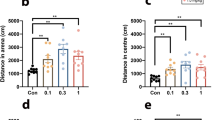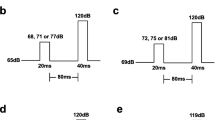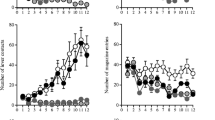Abstract
Rationale
Gz, a member of the Gi G protein family, is involved in the coupling of dopaminergic and serotonergic receptors. In the present study, we investigated behaviour of mice deficient in the α subunit of Gz and focused on pre-pulse inhibition (PPI) and anxiety-like responses and the role of serotonin-1A (5-HT1A) receptors.
Materials and methods
We compared male and female wild-type and knock-out mice on either a C57Bl/6 or Balb/c background. We used automated startle boxes to assess startle and PPI and elevated plus maze to assess anxiety-like behaviours.
Results
Balb/c mice showed higher baseline PPI than C57Bl/6 mice, and there was no difference between the genotypes. The 5-HT1A receptor agonist, 8-hydroxy-di-propylaminotetralin (8-OH-DPAT), had no effect on PPI in C57Bl/6 mice but markedly increased PPI in Balb/c mice, with the effect being attenuated in Gαz knock-outs. On the elevated plus maze, there was little effect of the knock-out or 8-OH-DPAT in C57Bl/6 mice, whereas in Balb/c mice, Gαz knock-outs showed a phenotype of high levels of anxiety-like behaviour. 8-OH-DPAT was anxiogenic in Balb/c mice, but this effect was attenuated in Gαz knock-outs.
Conclusions
5-HT1A receptors couple to Gz. In a strictly background strain-dependent manner, Gαz knock-out mice display high levels of anxiety-like behaviour and are less sensitive to the action of 8-OH-DPAT. Balb/c mice show much more clear effects of the Gαz knock-out than C57Bl/6 mice, which are often considered the standard background strain for genetic modifications. Therefore, our results suggest caution when studying the behavioural effects of genetic modifications only in C57Bl/6 mice.




Similar content being viewed by others
References
Albert PR, Lemonde S (2004) 5-HT1A receptors, gene repression, and depression: guilt by association. Neuroscientist 10:575–593
Bailey SJ, Toth M (2004) Variability in the benzodiazepine response of serotonin 5-HT1A receptor null mice displaying anxiety-like phenotype: evidence for genetic modifiers in the 5-HT-mediated regulation of GABAA receptors. J Neurosci 24:6343–6351
Bantick RA, Deakin JF, Grasby PM (2001) The 5-HT1A receptor in schizophrenia: a promising target for novel atypical neuroleptics? J Psychopharmacol 15:37–46
Bruening S, Oh E, Hetzenauer A, Escobar-Alvarez S, Westphalen RI, Hemmings HCJ, Singewald N, Shippenberg T, Toth M (2006) The anxiety-like phenotype of 5-HT receptor null mice is associated with genetic background-specific perturbations in the prefrontal cortex GABA-glutamate system. J Neurochem 99:892–899
Burnet PW, Eastwood SL, Harrison PJ (1996) 5-HT1A and 5-HT2A receptor mRNAs and binding site densities are differentially altered in schizophrenia. Neuropsychopharmacology 15:442–455
Cao BJ, Rodgers RJ (1996) Different behavioral profiles of the R(+)- and S(−)-enantiomers of 8-hydroxy-2-(di-n-propylamino) tetralin in the murine elevated plus-maze. Behav Pharmacol 7:810–819
Casey PJ, Fong HK, Simon MI, Gilman AG (1990) Gz, a guanine nucleotide-binding protein with unique biochemical properties. J Biol Chem 265:2383–2390
Crabbe JC, Wahlsten D, Dudek BC (1999) Genetics of mouse behavior: interactions with laboratory environment. Science 284:1670–1672
Crawley JN (1999) Behavioral phenotyping of transgenic and knockout mice: experimental design and evaluation of general health, sensory functions, motor abilities, and specific behavioral tests. Brain Res 835:18–26
Crawley JN, Belknap JK, Collins A, Crabbe JC, Frankel W, Henderson N, Hitzemann RJ, Maxson SC, Miner LL, Silva AJ, Wehner JM, Wynshaw-Boris A, Paylor R (1997) Behavioral phenotypes of inbred mouse strains: implications and recommendations for molecular studies. Psychopharmacology 132:107–124
Dawson GR, Tricklebank MD (1995) Use of the elevated plus maze in the search for novel anxiolytic agents. Trends Pharmacol Sci 16:33–36
Domschke K, Braun M, Ohrmann P, Suslow T, Kugel H, Bauer J, Hohoff C, Kersting A, Engelien A, Arolt V, Heindel W, Deckert J (2006) Association of the functional –1019C/G 5-HT1A polymorphism with prefrontal cortex and amygdala activation measured with 3 T fMRI in panic disorder. Int J Neuropsychopharmacol 9:349–355
Dudek BC, Underwood KA (1993) Selective breeding, congenic strains, and other classical genetic approaches to the analysis of alcohol-related polygenic pleiotropisms. Behav Genet 23:179–189
Dulawa SC, Geyer MA (2000) Effects of strain and serotonergic agents on prepulse inhibition and habituation in mice. Neuropharmacology 39:2170–2179
Dulawa SC, Gross C, Stark KL, Hen R, Geyer MA (2000) Knockout mice reveal opposite roles for serotonin 1A and 1B receptors in prepulse inhibition. Neuropsychopharmacology 22:650–659
Gerlai R (2001) Gene targeting: technical confounds and potential solutions in behavioral brain research. Behav Brain Res 125:13–21
Geyer MA, Krebs-Thomson K, Braff DL, Swerdlow NR (2001) Pharmacological studies of prepulse inhibition models of sensorimotor gating deficits in schizophrenia: a decade in review. Psychopharmacology 156:117–154
Geyer MA, McIlwain KL, Paylor R (2002) Mouse genetic models for prepulse inhibition: an early review. Mol Psychiatry 7:1039–1053
Gogos A, Kusljic S, van den Buuse M (2005) 8-OH-DPAT-induced effects on prepulse inhibition: Pre- vs. post-synaptic 5-HT1A receptor activation. Pharmacol Biochem Behav 81:664–672
Gogos A, Martin S, Jones ME, van den Buuse M (2006) Oestrogen modulation of the effect of 8-OH-DPAT on prepulse inhibition: effects of aromatase deficiency and castration in mice. Psychopharmacology 188:100–110
Hendry IA, Kelleher KL, Bartlett SE, Leck KJ, Reynolds AJ, Heydon K, Mellick A, Megirian D, Matthaei KI (2000) Hypertolerance to morphine in Gza-deficient mice. Brain Res 870:10–19
Hoyer D, Hannon JP, Martin GR (2002) Molecular, pharmacological and functional diversity of 5-HT receptors. Pharmacol Biochem Behav 71:533–554
Huang YY, Battistuzzi C, Oquendo MA, Harkavy-Friedman J, Greenhill L, Zalsman G, Brodsky B, Arango V, Brent DA, Mann JJ (2004) Human 5-HT1A receptor C(-1019)G polymorphism and psychopathology. Int J Neuropsychopharmacol 7:441–451
Leck KJ, Blaha CD, Matthaei KI, Forster GL, Holgate J, Hendry IA (2006) Gz proteins are functionally coupled to dopamine D2-like receptors in vivo. Neuropharmacology 51:597–605
Lesch KP, Gutknecht L (2004) Focus on The 5-HT1A receptor: emerging role of a gene regulatory variant in psychopathology and pharmacogenetics. Int J Neuropsychopharmacol 7:381–385
Lowther S, De Paermentier F, Cheetham SC, Crompton MR, Katona CL, Horton RW (1997) 5-HT1A receptor binding sites in post-mortem brain samples from depressed suicides and controls. J Affect Disord 42:199–207
Mannoury la Cour C, El Mestikawy S, Hanoun N, Hamon M, Lanfumey L (2006) Regional differences in the coupling of 5-hydroxytryptamine-1A receptors to G proteins in the rat brain. Mol Pharmacol 70:1013–1021
Matthaei KI (2004) Caveats of gene-targeted and transgenic mice. In: Lanza R, Weissman I, Thomson J, Pedersen R, Hogan B, Gearhart J, Blau H, Melton D, Moore M, Verfaillie C, Thomas ED, West M (eds) Handbook of stem cells, vol. 1. Elsevier, San Diego, pp 589–598
Micheau J, Van Marrewijk B (1999) Stimulation of 5-HT1A receptors by systemic or medial septum injection induces anxiogenic-like effects and facilitates acquisition of a spatial discrimination task in mice. Prog Neuropsychopharmacol Biol Psychiatry 23:1113–1133
Oleskevich S, Leck KJ, Matthaei K, Hendry IA (2005) Enhanced serotonin response in the hippocampus of Gaz protein knock-out mice. NeuroReport 16:921–925
Olivier B, Pattij T, Wood SJ, Oosting R, Sarnyai Z, Toth M (2001) The 5-HT1A receptor knockout mouse and anxiety. Behav Pharmacol 12:439–450
O’Tuathaigh CMP, Babovic D, O’meara G, Clifford JJ, Croke DT, Waddington JL (2007) Susceptibility genes for schizophrenia: characterisation of mutant mouse models at the level of phenotypic behaviour. Neurosci Biobehav Rev 31:60–78
Paylor R, Crawley JN (1997) Inbred strain differences in prepulse inhibition of the mouse startle response. Psychopharmacology 132:169–180
Pollak DD, John J, Schneider A, Hoeger H, Lubec G (2006) Strain-dependent expression of signaling proteins in the mouse hippocampus. Neuroscience 138:149–158
Raymond JR, Mukhin YV, Gettys TW, Garnovskaya MN (1999) The recombinant 5-HT1A receptor: G protein coupling and signalling pathways. Br J Pharmacol 127:1751–1764
Reynolds GP, Arranz B, Templeman LA, Fertuzinhos S, San L (2006) Effect of 5-HT1A receptor gene polymorphism on negative and depressive symptom response to antipsychotic treatment of drug-naive psychotic patients. Am J Psychiatry 163:1826–1829
Rodgers RJ (1997) Animal models of ‘anxiety’: where next? Behav Pharmacol 8:477–496
Trullas R, Skolnick P (1993) Differences in fear motivated behaviors among inbred mouse strains. Psychopharmacology 111:323–331
van den Buuse M, Martin S, Brosda J, Leck KJ, Matthaei KI, Hendry I (2005) Enhanced effect of dopaminergic stimulation on prepulse inhibition in mice deficient in the alpha subunit of Gz. Psychopharmacology 183:358–367
Van den Buuse M, van Driel IR, Samuelson LC, Pijnappel M, Martin S (2005) Reduced effects of amphetamine on prepulse inhibition of startle in gastrin-deficient mice. Neurosci Lett 373:237–242
van der Staay FJ, Steckler T (2002) The fallacy of behavioral phenotyping without standardisation. Genes Brain Behav 1:9–13
Yang JY, Wu J, Kowalska A, Dalvi A, Prevost N, O’Brien PJ, Manning D, Poncz M, Lucki I, Blendy JA, Brass LF (2000) Loss of signalling through the G protein, Gz, results in abnormal platelet activation and altered responses to psychoactive drugs. Proc Natl Acad Sci USA 97:9984–9989
Acknowledgements
These studies were supported by the Percy Baxter Charitable Trust, Australia. At the time of some of these experiments, the Mental Health Research Institute was a Stanley Research Centre supported by the Stanley Medical Research Institute, Bethesda, MD, USA. The authors have no conflict of interest to report.
Author information
Authors and Affiliations
Corresponding author
Rights and permissions
About this article
Cite this article
van den Buuse, M., Martin, S., Holgate, J. et al. Mice deficient in the alpha subunit of Gz show changes in pre-pulse inhibition, anxiety and responses to 5-HT1A receptor stimulation, which are strongly dependent on the genetic background. Psychopharmacology 195, 273–283 (2007). https://doi.org/10.1007/s00213-007-0888-7
Received:
Accepted:
Published:
Issue Date:
DOI: https://doi.org/10.1007/s00213-007-0888-7




